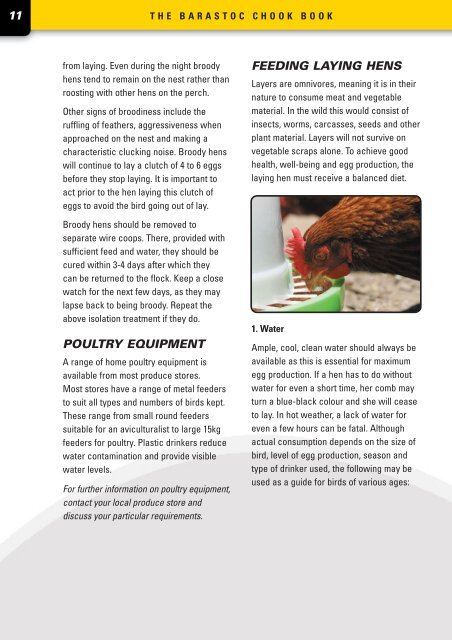THE CHOOK BOOK - Ridley Corporation
THE CHOOK BOOK - Ridley Corporation
THE CHOOK BOOK - Ridley Corporation
Create successful ePaper yourself
Turn your PDF publications into a flip-book with our unique Google optimized e-Paper software.
11 <strong>THE</strong> BARASTOC <strong>CHOOK</strong> <strong>BOOK</strong> <strong>THE</strong> BARASTOC <strong>CHOOK</strong> <strong>BOOK</strong><br />
12<br />
from laying. Even during the night broody<br />
hens tend to remain on the nest rather than<br />
roosting with other hens on the perch.<br />
Other signs of broodiness include the<br />
ruffling of feathers, aggressiveness when<br />
approached on the nest and making a<br />
characteristic clucking noise. Broody hens<br />
will continue to lay a clutch of 4 to 6 eggs<br />
before they stop laying. It is important to<br />
act prior to the hen laying this clutch of<br />
eggs to avoid the bird going out of lay.<br />
Broody hens should be removed to<br />
separate wire coops. There, provided with<br />
sufficient feed and water, they should be<br />
cured within 3-4 days after which they<br />
can be returned to the flock. Keep a close<br />
watch for the next few days, as they may<br />
lapse back to being broody. Repeat the<br />
above isolation treatment if they do.<br />
POULTRY EQUIPMENT<br />
A range of home poultry equipment is<br />
available from most produce stores.<br />
Most stores have a range of metal feeders<br />
to suit all types and numbers of birds kept.<br />
These range from small round feeders<br />
suitable for an aviculturalist to large 15kg<br />
feeders for poultry. Plastic drinkers reduce<br />
water contamination and provide visible<br />
water levels.<br />
For further information on poultry equipment,<br />
contact your local produce store and<br />
discuss your particular requirements.<br />
FEEDING LAYING HENS<br />
Layers are omnivores, meaning it is in their<br />
nature to consume meat and vegetable<br />
material. In the wild this would consist of<br />
insects, worms, carcasses, seeds and other<br />
plant material. Layers will not survive on<br />
vegetable scraps alone. To achieve good<br />
health, well-being and egg production, the<br />
laying hen must receive a balanced diet.<br />
1. Water<br />
Ample, cool, clean water should always be<br />
available as this is essential for maximum<br />
egg production. If a hen has to do without<br />
water for even a short time, her comb may<br />
turn a blue-black colour and she will cease<br />
to lay. In hot weather, a lack of water for<br />
even a few hours can be fatal. Although<br />
actual consumption depends on the size of<br />
bird, level of egg production, season and<br />
type of drinker used, the following may be<br />
used as a guide for birds of various ages:<br />
DAILY WATER CONSUMPTION GUIDE<br />
Age (Weeks) Litres (10 Birds)<br />
1 0.2<br />
5 1.0<br />
15 2.3<br />
20 2.6<br />
25 4.0<br />
30 5.0<br />
Saline water can be a cause of poor shell<br />
quality and wet manure. To check the<br />
suitability of your water supply, contact<br />
your State Department of Agriculture or<br />
Primary Industries or a recognised analytical<br />
laboratory.<br />
Note: In extremely hot weather a good rule<br />
to follow is to provide at least three times<br />
the usual water allowance.<br />
2. Protein and energy<br />
Birds require an appropriate balance of<br />
protein and energy to support growth, egg<br />
production, daily functions and overall<br />
health. Barastoc laying hen feeds (see<br />
product guide) have been formulated to<br />
ensure that the requirements for these<br />
nutrients are met.<br />
3. Vitamins and minerals<br />
Barastoc laying hen feeds (see product<br />
guide) are supplemented with vitamins and<br />
minerals to support egg production, essential<br />
body functions and resistance to disease.<br />
4. Coarse sources of calcium<br />
Calcium is required for strong bones and<br />
good quality eggshells. Barastoc laying hen<br />
feeds (see product guide) contain sufficient<br />
calcium to satisfy your hens’ needs. Hens<br />
generally lay down egg shells during the<br />
night. It can be beneficial to also offer<br />
coarse sources of calcium such as shell<br />
grit or limestone chips. These provide a<br />
sustained slow-release of calcium and allow<br />
for the selection of extra calcium by hens.<br />
5. Hard grit<br />
Hens use small insoluble stones to grind<br />
feed in the gizzard. They require grit when<br />
being fed coarse grains such as wheat or<br />
other feedstuffs where grinding is necessary<br />
for digestion. Grit is generally described<br />
as small insoluble stones of approximately<br />
3mm (1/8'') in diameter.<br />
6. Green feed and scraps<br />
Green feeds and scraps are a source of<br />
vitamins and can contribute carotenoid<br />
pigments for yolk colour. Hens enjoy grazing<br />
and picking over scraps and whilst these<br />
can contribute to their diet, they can also<br />
be very low in nutrients. If too much poor<br />
quality forage or scraps are fed too often in<br />
place of a balanced ration, egg production<br />
and hen health can suffer.<br />
Care should be taken to avoid access to<br />
mouldy or “off ” feed such as old damp<br />
stored grain or mouldy bread. These<br />
may contain toxins that can affect the<br />
health and performance of laying hens.<br />
The practice of wetting pellets is<br />
unnecessary and potentially harmful. Milk<br />
should not be added to feedstuffs due to<br />
the risk of promoting bacterial growth.


